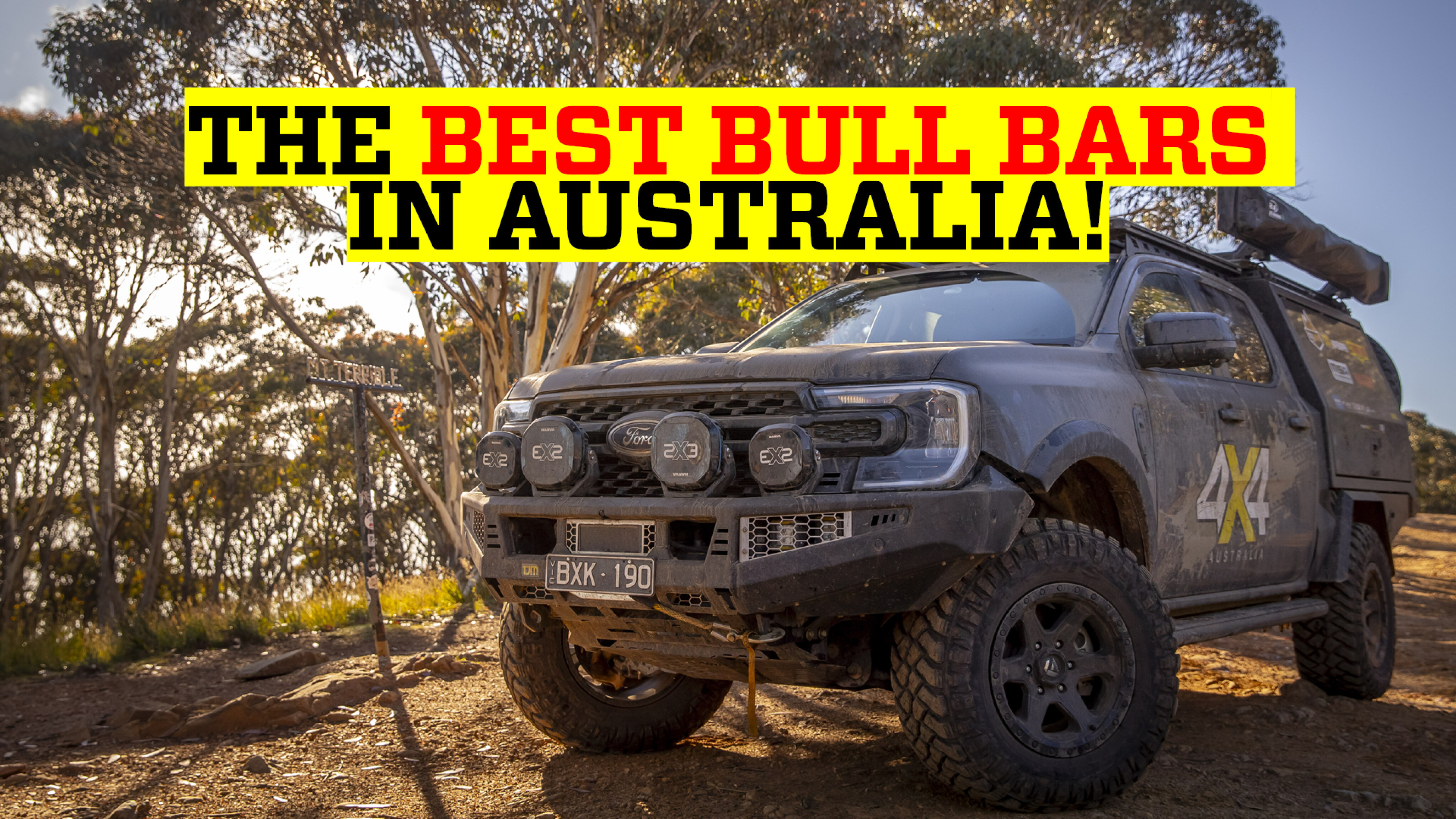
Bull bars are virtually essential for 4x4s in Australia … at least for anyone who travels out of the cities.
They’re cheap insurance against animal strikes, where an encounter with a kangaroo can take out your radiator. Far better to spend a few bucks on a decent bull bar than be stranded in the middle of nowhere. Even if you live just out of town, chances are you’ll have an unwelcome meeting with a stray animal sooner or later.
Bull bars also protect the front of your vehicle from wayward trees, branches, stumps, and even large boulders when you’re picking your way through a tight bush track. And they’re the perfect spot to mount winches, aerials and driving lights.
So what’s available on the local market? Plenty as it turns out. To help you narrow down your choices, we’ll go through the various bull bar suppliers. They each have stacks of models in steel and alloy … some even supply polyurethane bars.
JUMP AHEAD
- AFN
- ARB
- Dobinsons
- East Coast Bullbars (ECB)
- EFS 4x4 Accessories
- Ironman 4x4
- MAX 4x4 Accessories
- Opposite Lock Premium
- RAXAR
- Oxley
- PIAK
- TJM
- XROX
AFN
AFN bull bars are manufactured in Portugal by a company which supplies military equipment. It supplies both a three-hoop and a no-hoop design.
All AFN bull bars are airbag-compatible, ADR-compatible and winch-compatible. They include dual aerial mounts, driving-light mounts and high-lift jacking points. These bars fit snugly to minimise front overhang and maximise front clearance angle.
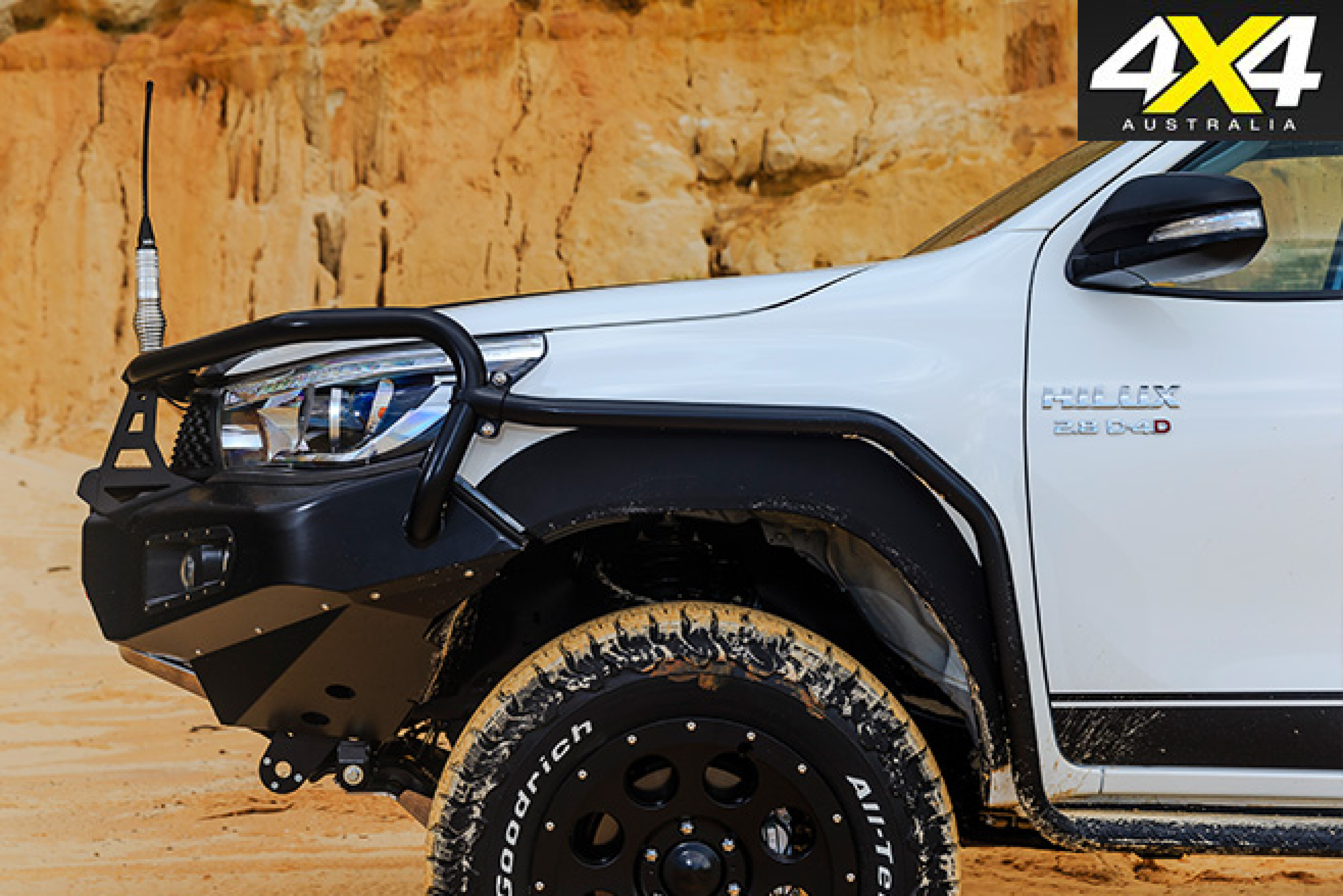
| Materials | Steel |
|---|---|
| Coatings | Powder-coated |
| Warranty | 2 years (structural); 1 year (finish) |
ARB
ARB has a range of 11 bull bars including Commercial, Deluxe, Sahara, alloy and polyurethane bars.
Commercial bars are where functionality and cost are the highest priorities. A simplified manufacturing process makes these bars perfectly suited to fleet and government vehicles. Deluxe bars are ARB’s traditional bar, and they’re fully compatible with safety features like collision avoidance and adaptive cruise control. Sahara bars have all the features of a full bull bar, but only have one hoop to protect the radiator.
Alloy bars are for those seeking something lighter than steel, while polyurethane bars are rotational-moulded as one piece and are ideal for applications where weight is critical. Most bull bars are available as winch bars. All are airbag- and ADR-compatible. Fog and indicator lights are recessed for added protection, and some models are compatible with side protection rails.
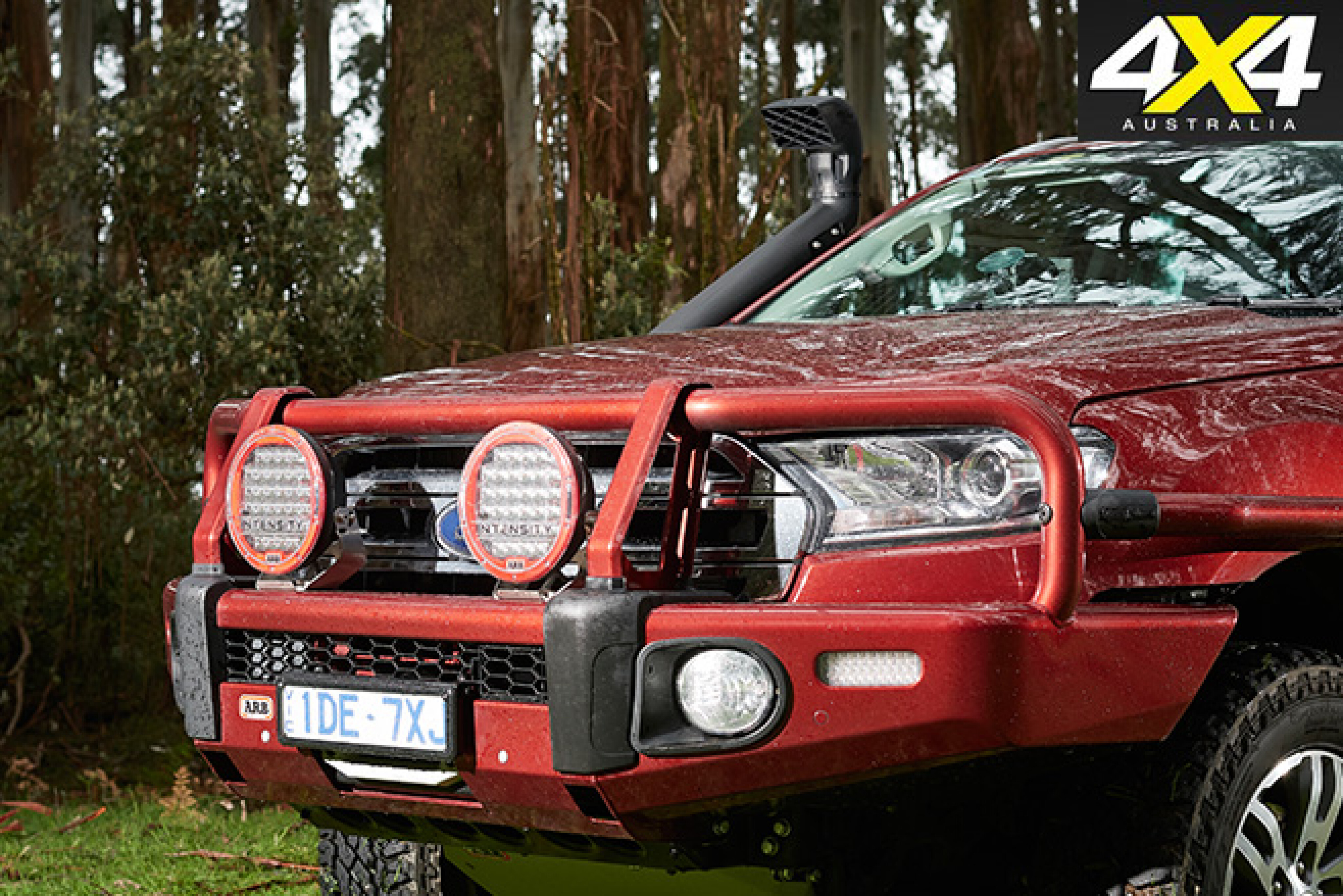
| Materials | Alloy, steel or polycarbonate |
|---|---|
| Coatings | Polished, colour coded or painted |
| Warranty | 3 years |
Dobinsons
Dobinsons bull bars are designed and manufactured locally by Outback Accessories, and it makes three models, all steel and all powder-coated.
The Classic Black is a functional design for fleets, government vehicles and tradies; the Classic Black Deluxe includes driving lights; and the Stainless Loop Deluxe features stainless-steel hoops. All Dobinsons bull bars are airbag-compatible, ADR-compatible and winch-compatible. They include dual aerial mounts, driving-light mounts and high-lift jacking points.
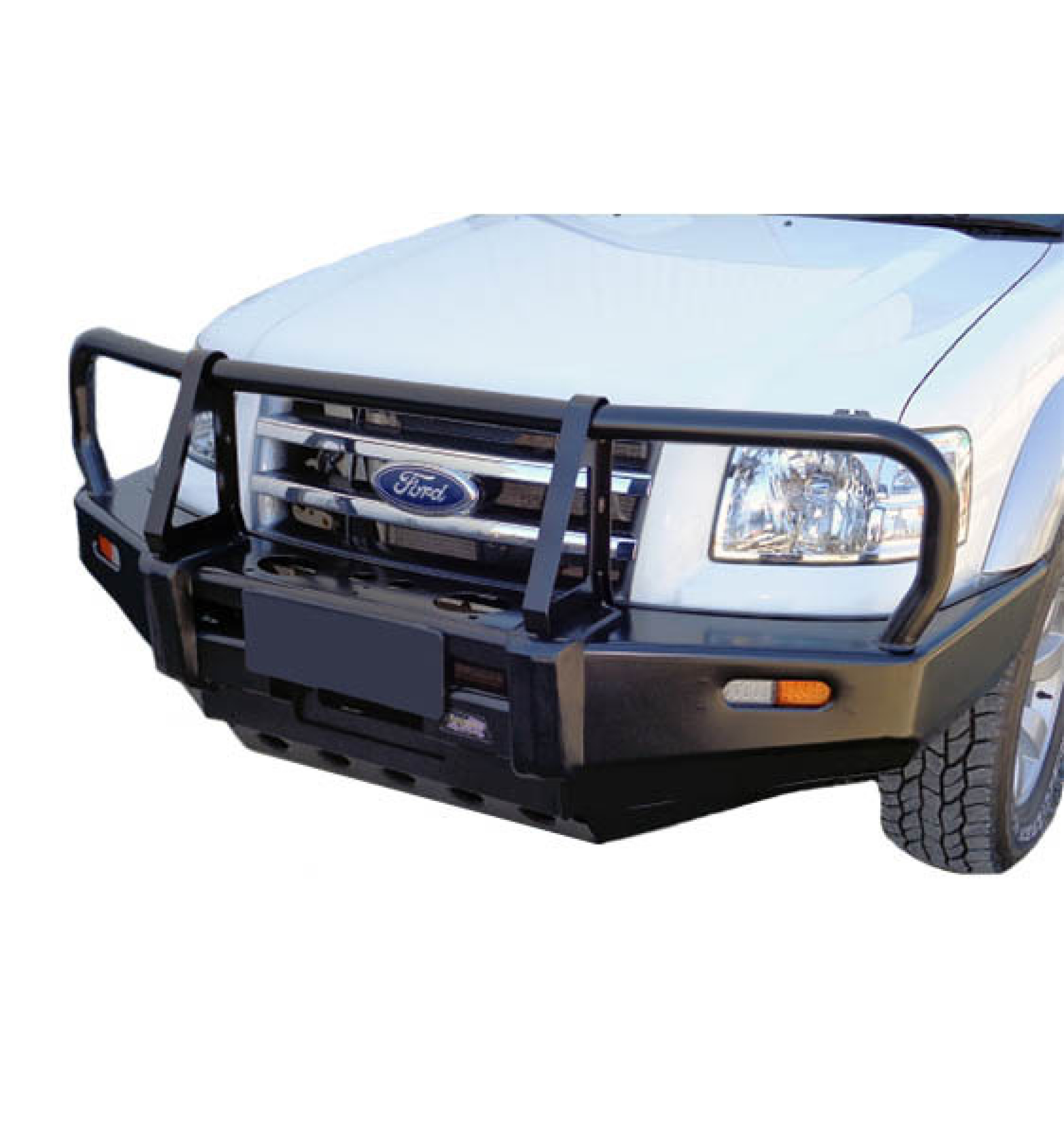
| Materials | Steel |
|---|---|
| Coatings | Powder-coated |
| Warranty | 1 year |
East Coast Bullbars (ECB)
ECB starting manufacturing bull bars in Australia in 1971. It specialises in alloy bull bars for 4WDs, vans and trucks, and its bull bars range from lightweight nudge bars and ’roo bars to premium winch bars.
All its bull bars are designed to be compatible with safety features like adaptive cruise control, parking sensors, and so on. ECB’s Big Tube Bar is the signature product. It includes fog lights and is available with or without winch mountings. The Roo Bar sits over the OEM bumper bar, like a nudge bar, and it protects the bumper, grille and headlights. It has mounting tabs to fit driving lights. The Midi Tube Bar is similar to the Roo Bar, but it’s designed to protect the OEM bumper, grille and fog lights.
The Roo Bar and Midi Tube Bar are both low-weight and low-cost options if you don’t have the coin for a full bumper bar replacement. All bull bars are airbag compatible and ADR compatible. ECB uses an industry-leading mirror-polished finish or high-quality powder-coated finishes, depending on your needs.

| Materials | Alloy |
|---|---|
| Coatings | Mirror polished or powder-coated |
| Warranty | Lifetime |
EFS 4x4 Accessories
EFS supplies two types of bull bars, the Adventure range and the X-Cape. Its bull bars are designed locally and manufactured overseas.
The Adventure range is the premium model and it is winch-compatible and features recessed fog and indicator lights, infill trims under the headlights, and lower bull bar skid plates. The X-Cape is a winch-compatible bumper bar replacement with no hoops. It has all the features of the Adventure range, minus the hoops. All bull bars are airbag-compatible and ADR-compatible.
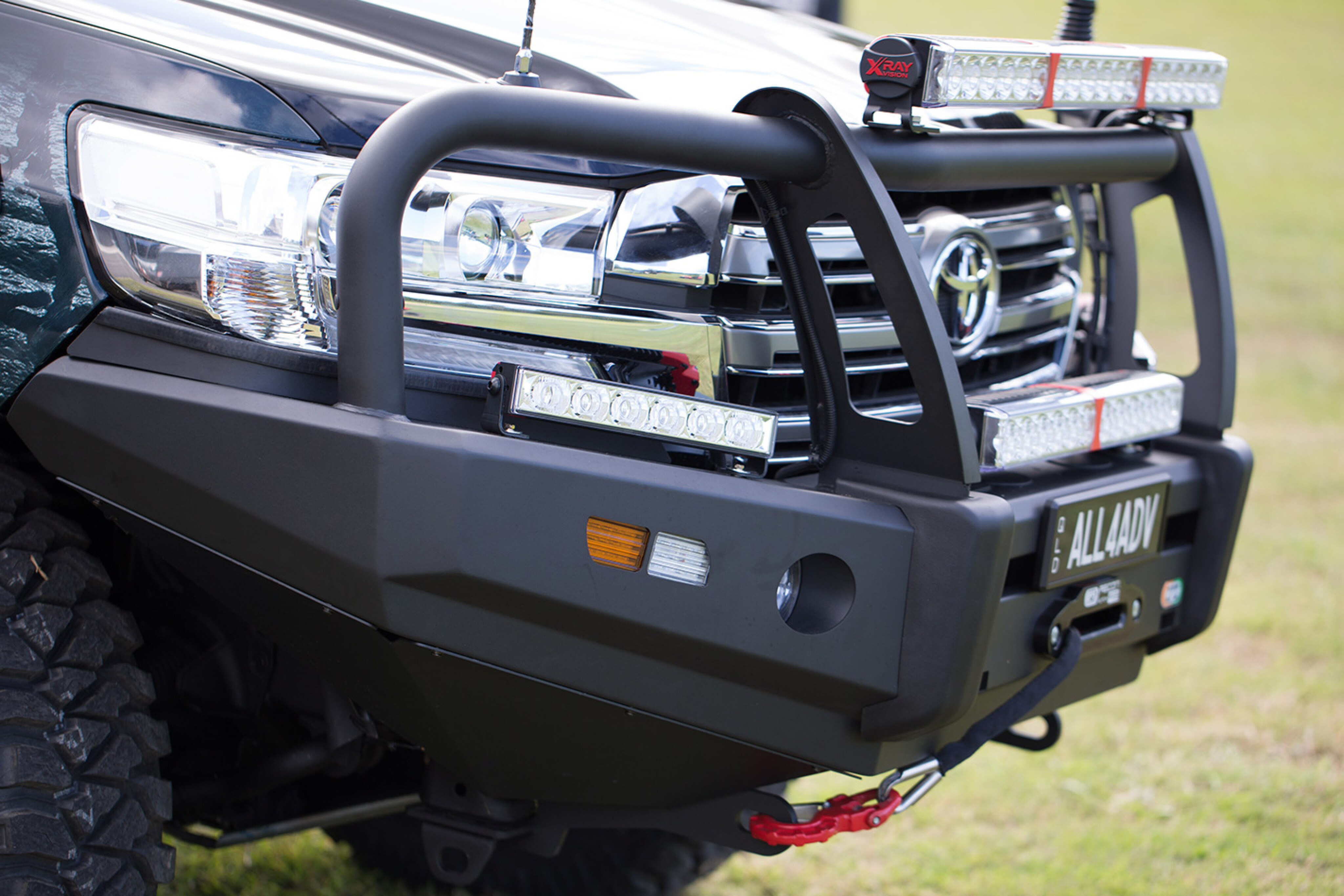
| Materials | Steel |
|---|---|
| Coatings | Endura-Coat |
| Warranty | 2 years |
Ironman 4x4
Ironman 4x4 has seven bull bars in its range including Commercial Premium Deluxe and Proguard.
Commercial bars are designed for function and practicality, and they're Ideal for fleets and government buyers where cost is a major consideration. The Premium Deluxe bars include extras like integrated fog lights and colour-coding. The Proguard bar is customisable as a no-hoop, one-hoop, or three-hoop bar. And Alloy bars have all the features of the Premium Deluxe bars, with the advantage of lighter weight.
All bull bars are winch-compatible, airbag-compatible, ADR-compatible, and have high-lift jack points. Recessed fog and indicator lights are for added protection, and most models are compatible with side protection rails.
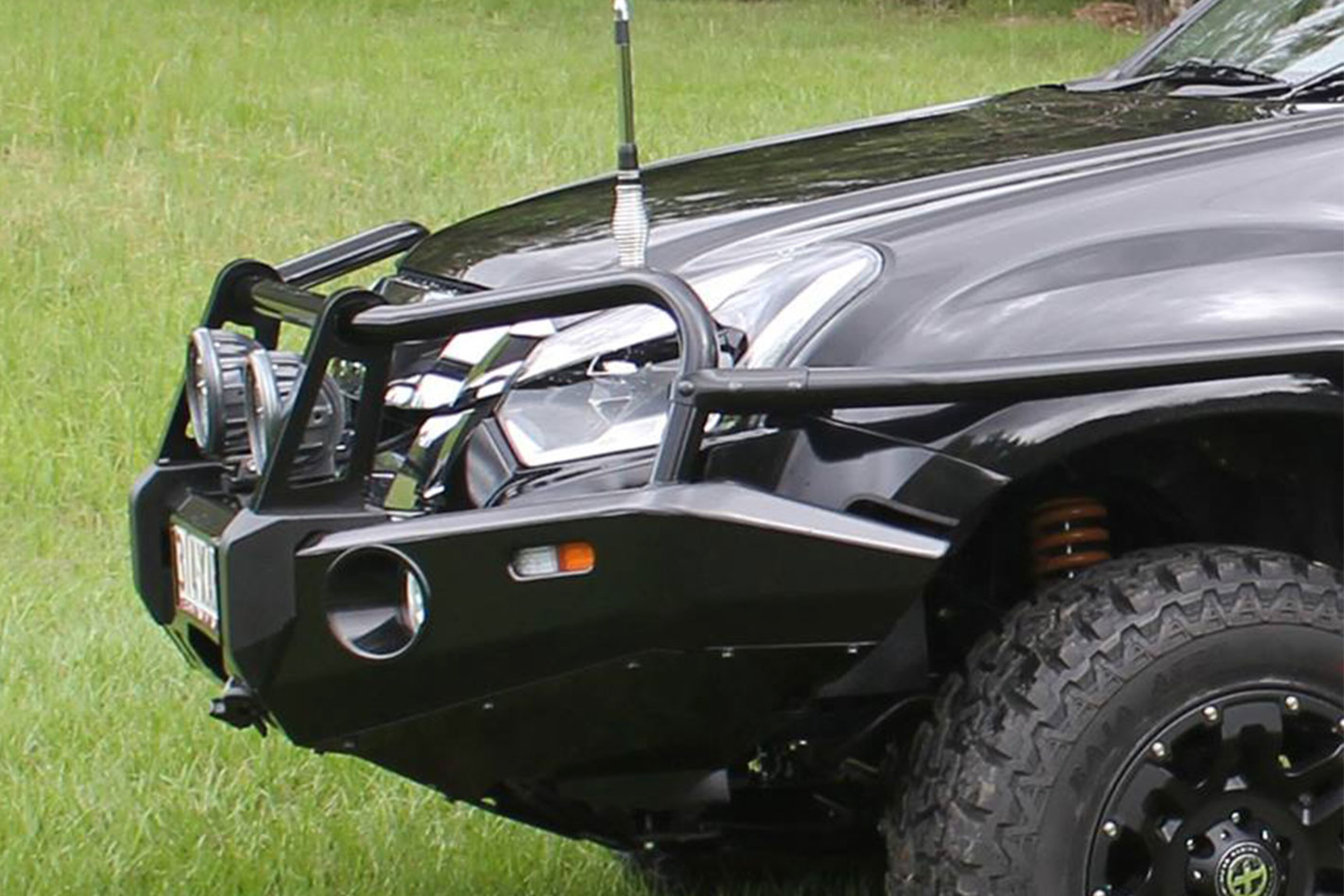
| Materials | Alloy or steel |
|---|---|
| Coatings | Polished, colour-coded or painted |
| Warranty | 1 year |
MAX 4x4 Accessories
MAX bull bars are designed locally and manufactured overseas. The range includes four models which has one alloy option.
Features include mounts for driving lights; two mounts for aerials; two rated recovery points; two high-lift jacking points; and a provision for mounting fog lights. They’re airbag-compatible, ADR-compatible and winch-compatible.
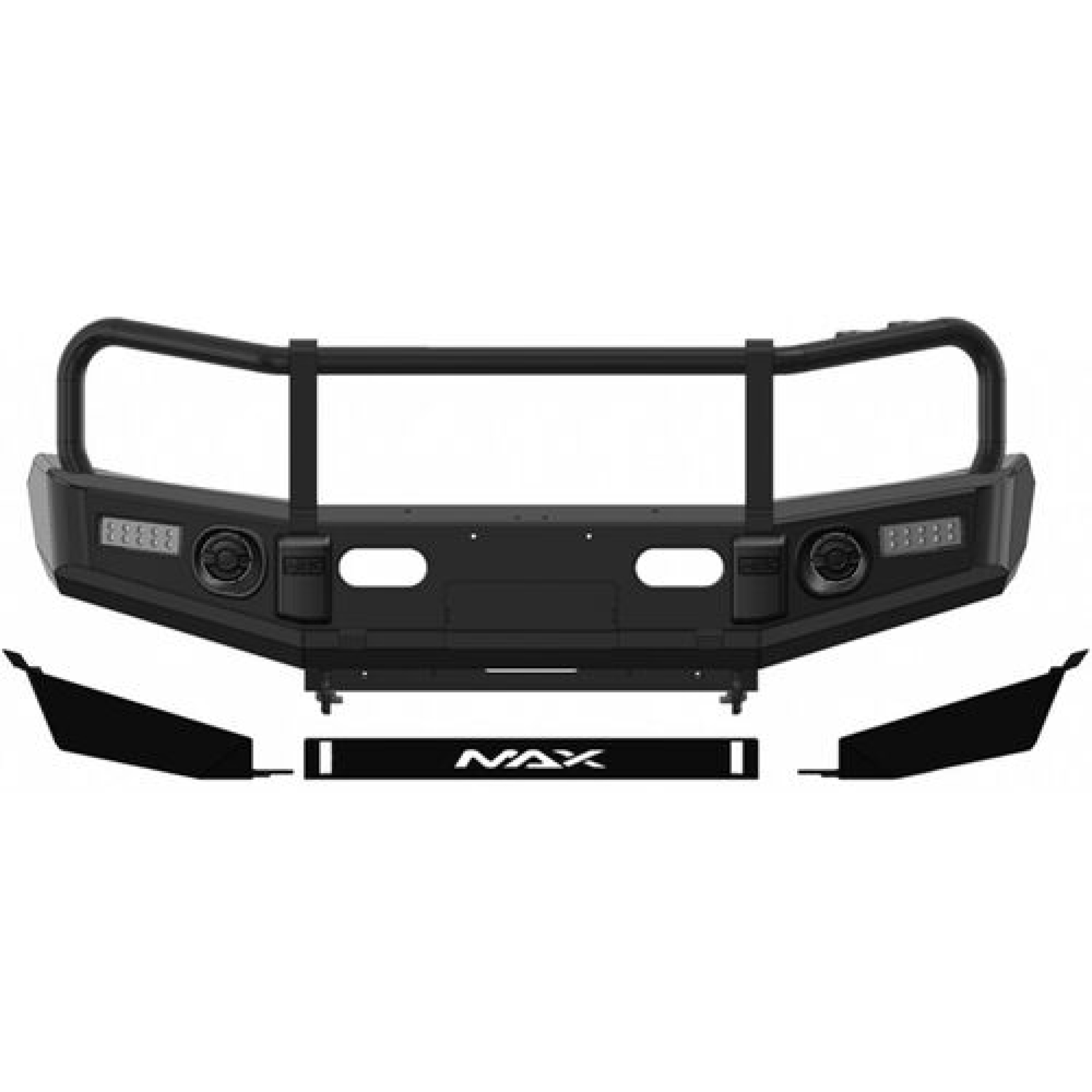
| Materials | Alloy or steel |
|---|---|
| Coatings | Powder-coated or polished |
| Warranty | 2 years |
Opposite Lock Premium
Opposite Lock’s spin on traditional frontal protection is that it’s uniquely designed and engineered in Australia to complement and enhance the vehicle’s original aesthetics.
Engineers have designed these bars to offer maximum frontal impact protection whilst being packed with features that allow the personalisation of your vehicle, ready to be equipped with a wide range of off-road accessories. The Opposite Lock Bull Bar has evolved to travel every journey from day-to-day driving to tackling some of the most extreme adventures. Made from high-grade steel to offer outstanding protection, functionality and good looks.
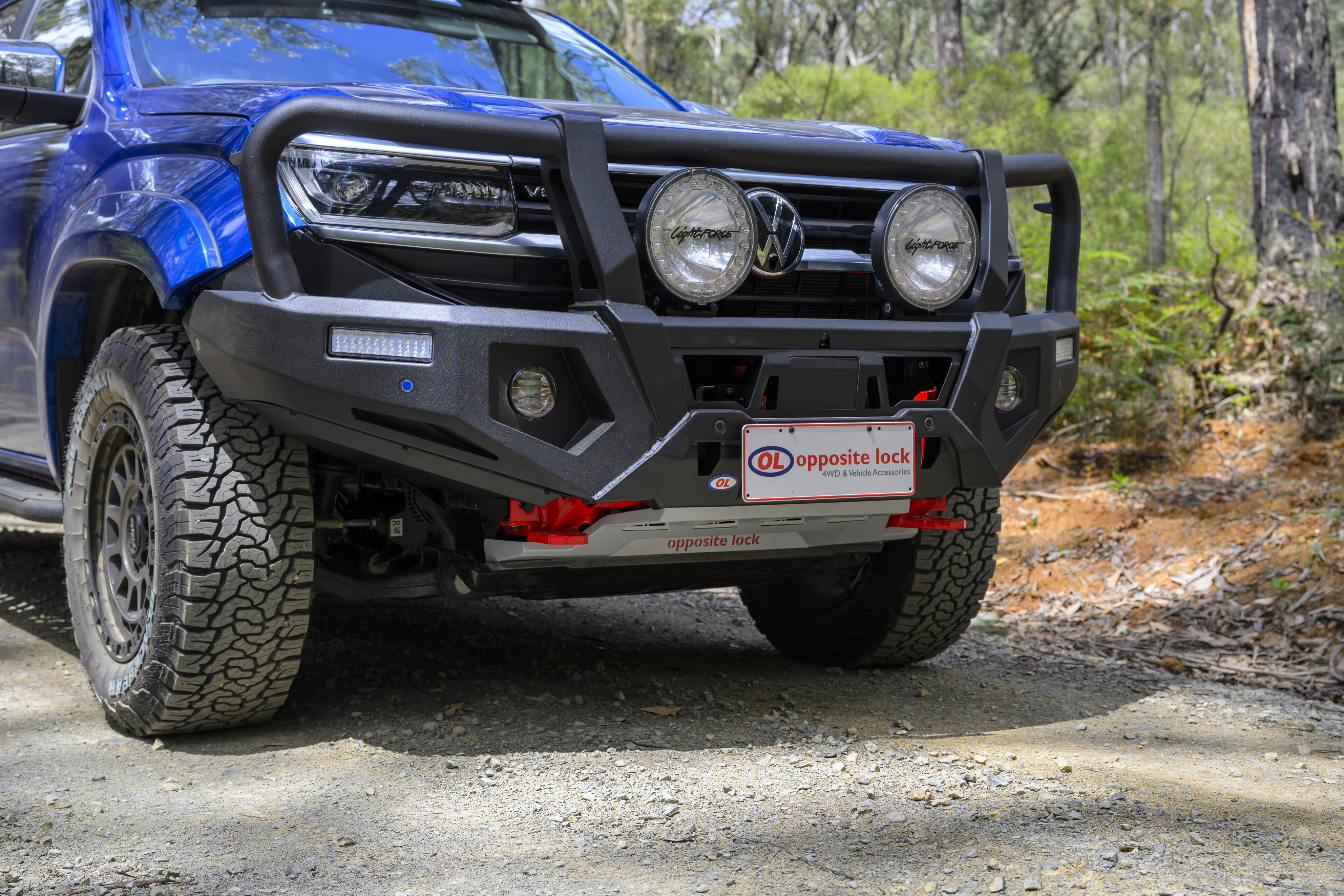
| Materials | High-grade steel |
|---|---|
| Coating | Durable matte black powder coating - colour coding available |
| Warranty | Two years |
RAXAR
RAXAR bull bars, 4WD accessories and touring gear is for those who are passionate about their rig, enjoy the outdoors and take pride in their 4WD’s appearance.
RAXAR specialise in high-quality 4x4 accessories and equipment for off-road vehicles that is at the cutting-edge of design and innovation. The growing range of products is tough, reliable, functional and designed to meet your needs. Whether it be on the worksite, the street, or your next adventure, let RAXAR take you there in style.
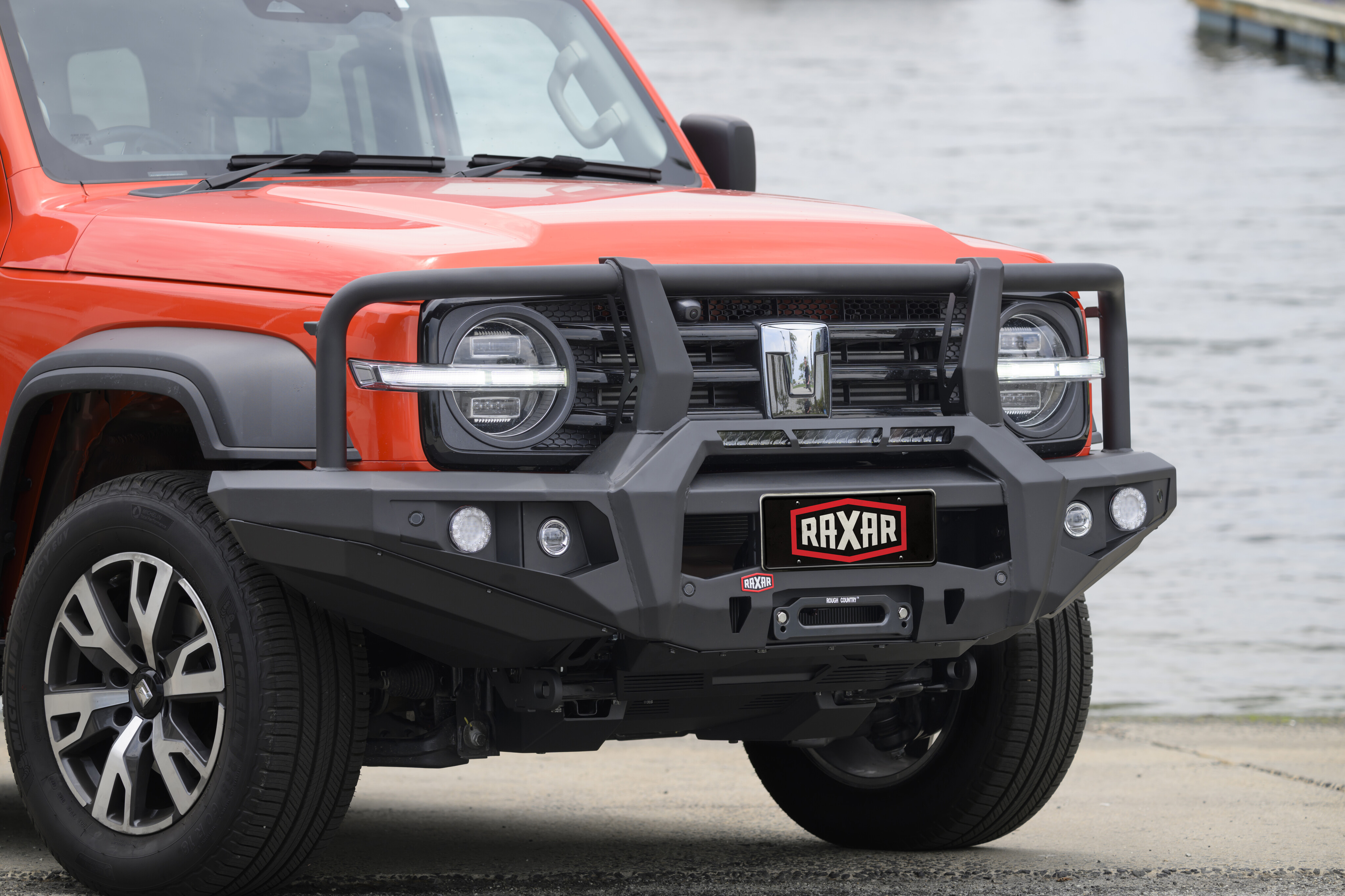
| Materials | High-grade steel |
|---|---|
| Coating | E-coated and Powder coated matte black for a durable finish |
| Warranty | Two years |
Oxley
Opposite Lock offers a classic range of “no nonsense, value for money” products.
This includes 4WD bull bars, steps, rails, and under-body protection products that are designed for trade and fleet vehicles, as well as anyone looking for a quality bull bar.
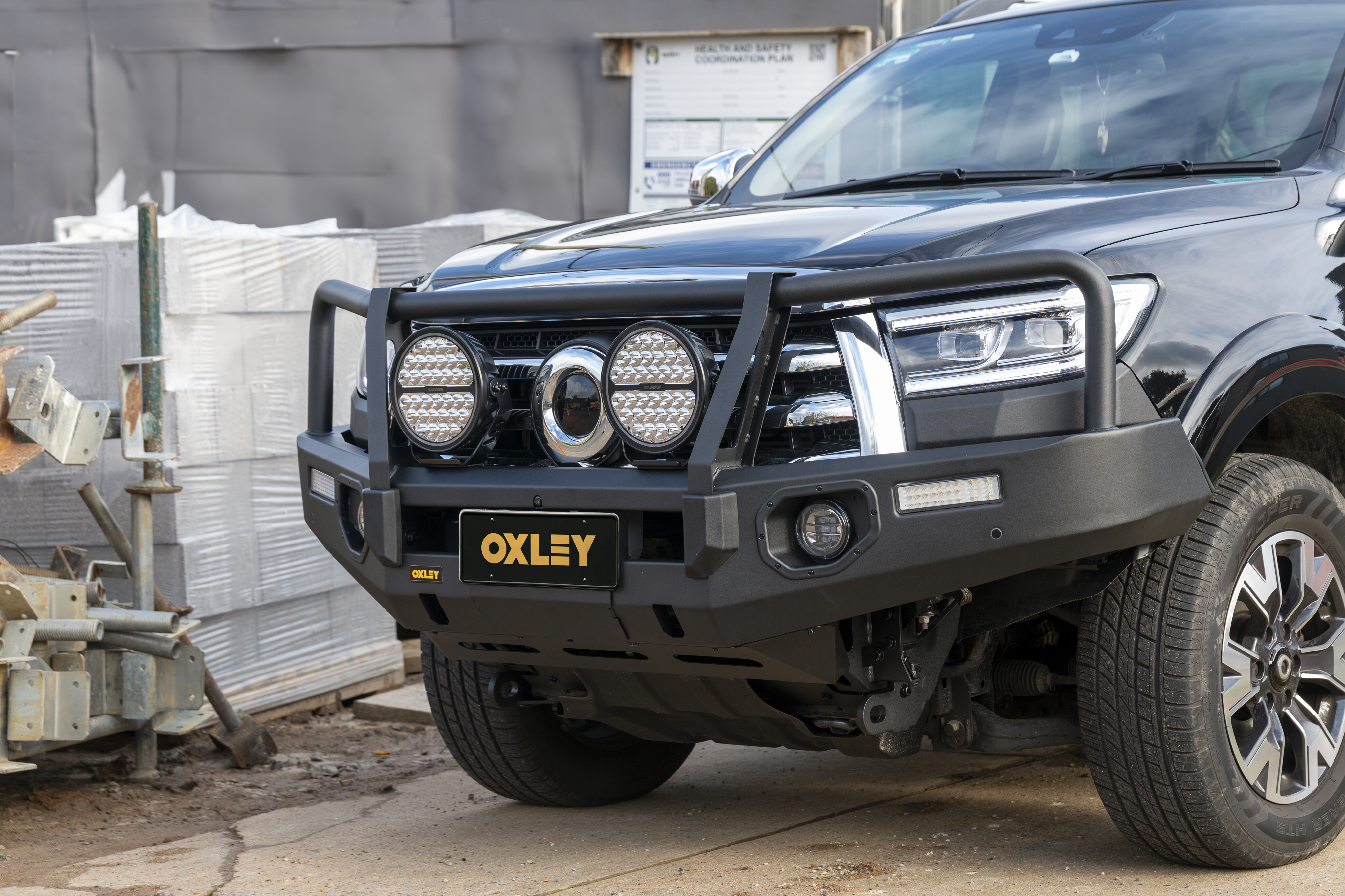
| Materials | High-grade steel |
|---|---|
| Coating | Durable e-coating & powder coated finish. |
| Warranty | Two years |
PIAK
PIAK bull bars are designed and manufactured overseas, and the range includes two models which are both available as three-or no-hoop designs.
The Elite range is what PIAK calls ‘tech-compatible’, meaning they’re compatible with parking sensors, adaptive cruise control and the like. The Premium range are compatible with parking sensors and are designed for older 4WDs. All PIAK bull bars are airbag-compatible, ADR-compatible and winch-compatible.
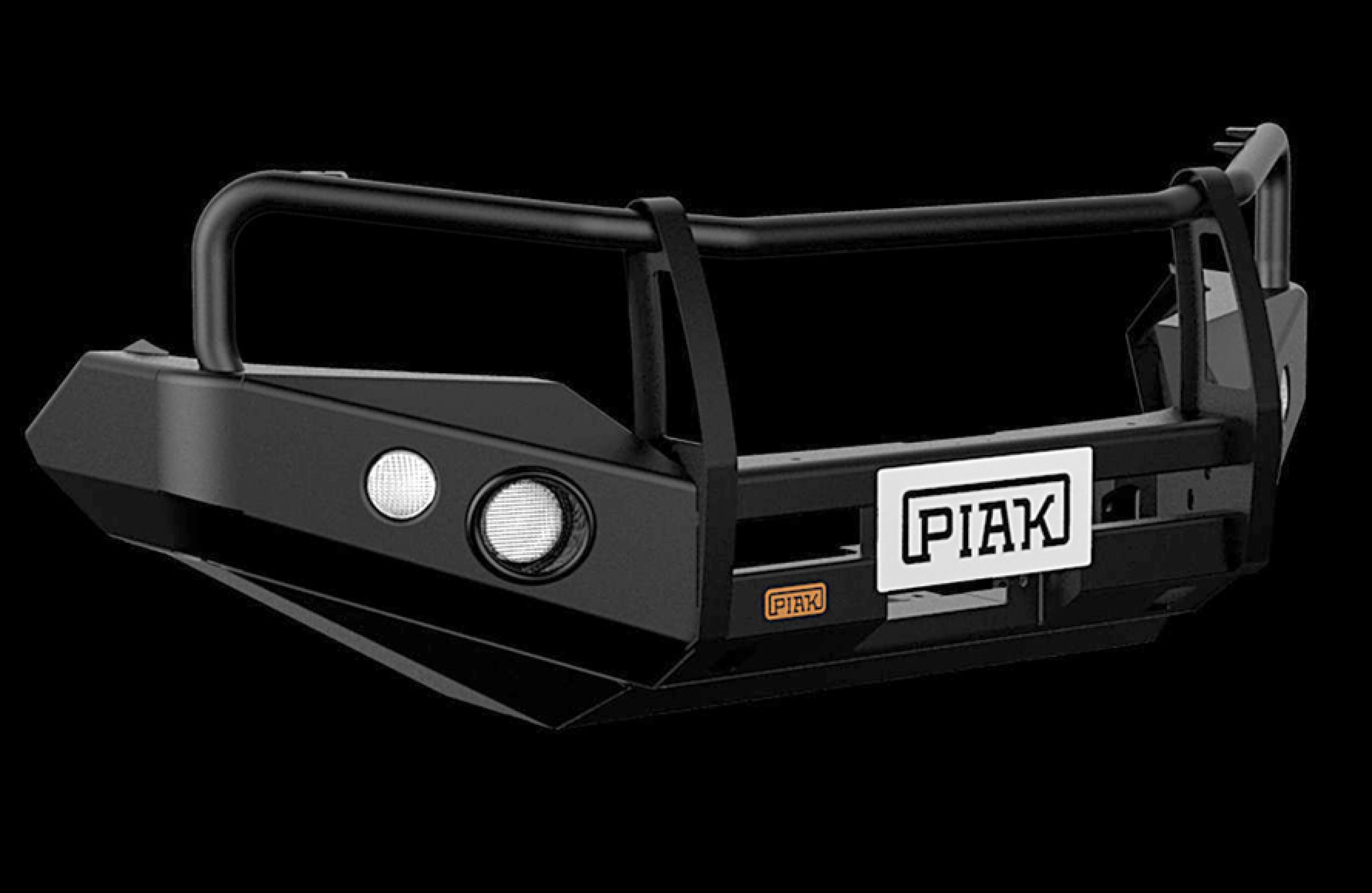
| Materials | Steel |
|---|---|
| Coatings | Powder-coated |
| Warranty | 2 years |
TJM
TJM bull bars are designed locally and manufactured overseas, and they cover a wide variety of vehicle makes and models, primarily with steel bull bars.
The range includes Tradesman, a functional three-hoop bar designed for fleet vehicles and tradies; the steel Outback and alloy Signature, TJM’s premium three-hoop models; the Explorer and Frontier, available with a steel or a polished alloy hoop to protect the radiator; and Venturer, Chaser and Covert no-hoop bars, replacements for the bumper bar with increased approach angle clearance over the OEM bumper bar.
Most TJM bull bars are winch-compatible and all steel bars have high-lift jacking points. A handy feature is the twin aerial mounts. All bull bars are airbag-compatible and ADR-compatible.
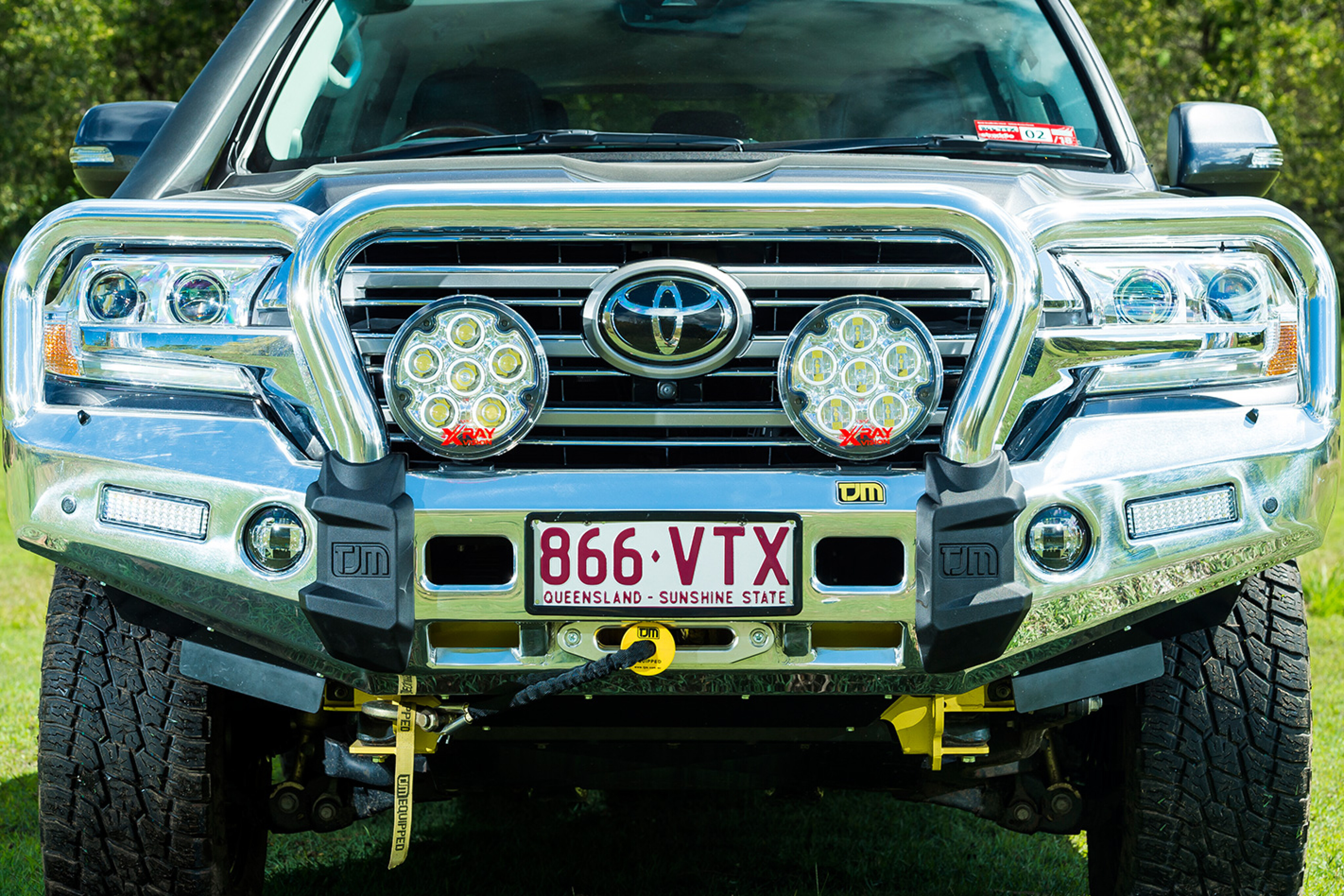
| Materials | Steel or alloy |
|---|---|
| Coatings | Powder-coated or polished |
| Warranty | 3 years |
XROX
XROX bull bars were originally designed for comp trucks but have gained popularity in the recreational 4WD market.
Xrox have a range of features including two high-lift jacking points; four recovery hook locations; four mountings for spotlights and aerials; detachable side wings to allow easy replacement; and winch compatibility. All XROX bull bars are airbag- and ADR-compatible. Most are a one-hoop design to protect the radiator and to allow additional mounting points for aerials, sand flags and driving lights. The remainder are the no-hoop design, so you lose the extra mounting points but maintain all other features.
Its comp truck heritage means the bull bars have a massive approach-angle clearance, plus a super-solid construction. The replaceable wings are a great idea for those who love taking 4WDing to the extreme.
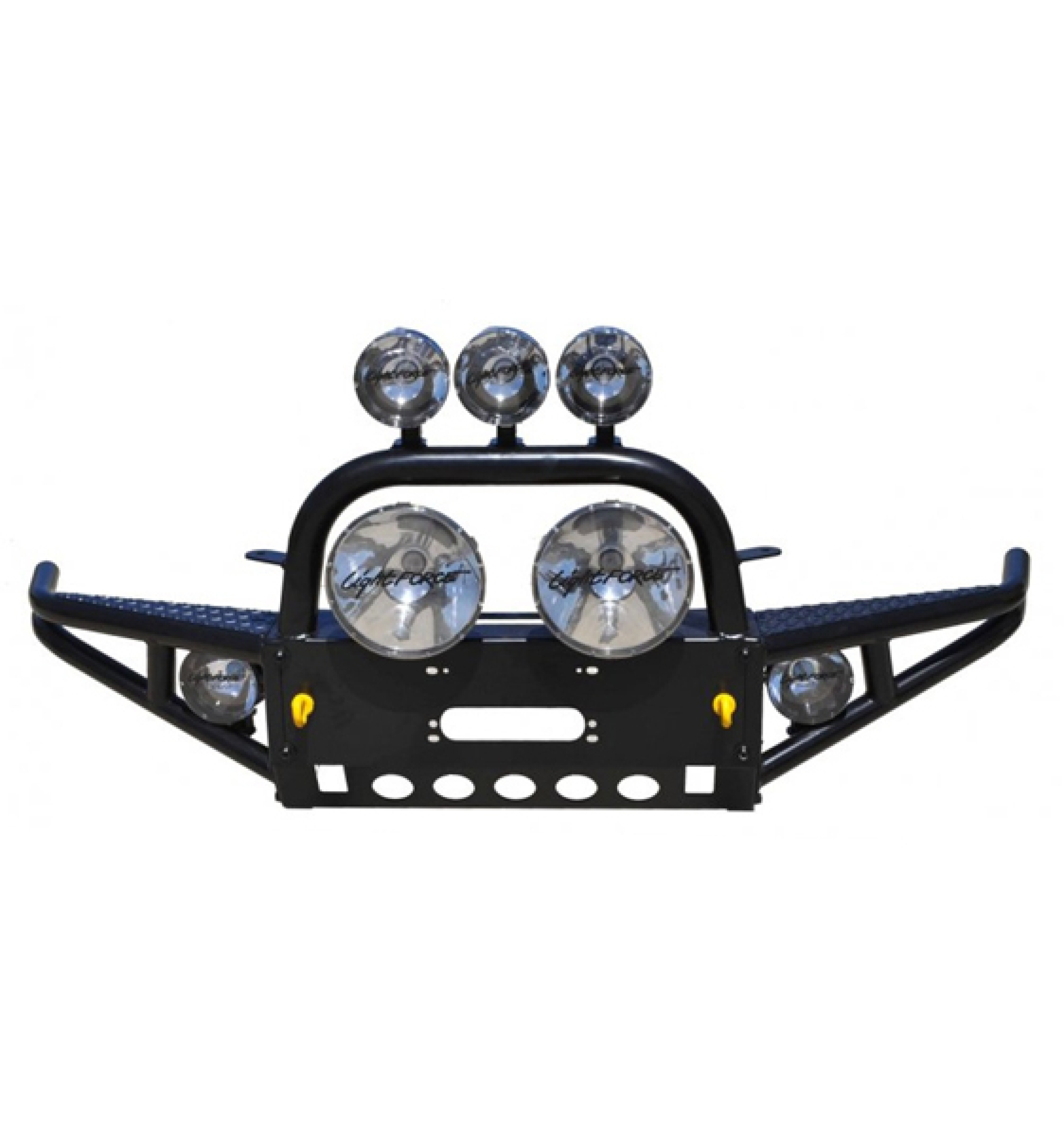
| Materials | Steel |
|---|---|
| Coatings | Powder-coated |
| Warranty | N/A |
A buyers' guide to bull bars
Why install an aftermarket bullbar? Two main reasons: protection and convenience.
A quality bullbar will afford the front of your vehicle (and all of the important mechanical bits) superior protection from kamikaze animals and wayward drivers, but it will also protect in dense scrub when truly off-road on the hunt for an elusive, out-of-the-way campsite.
Depending on the type fitted and what it’s made of, a good-quality bullbar will absorb the majority of impacts and protect the bits of the car that matter – namely the radiator and cooling system. A good bullbar will also provide a great base from which to attach other essential off-road kit – winches, light bars, LEDs and antennas.
A by-product of a bullbar, but an aspect important to many off-roaders, is the aesthetic enhancements a top-quality unit affords. Get the right one and you’ll have a bullbar that not only does the job, but looks the goods as well.
Why you need a good quality bar
You may think picking up an eBay special will save you a few pennies, but you’d be wrong. It may save you a few bucks in the short-term, but it’ll come back to bite you on the arse in the long run.
While an el-cheapo bullbar may look like the real thing on the outside, appearances can be deceiving. Steve Sampson, ARB’s product manager, explained: “A lot of the differences won’t so much be on the parts you see of the bar, as the outer appearance of the bar will look similar [to a high quality one].
One of the most important things is how the bar is attached to the chassis, and whether airbags will still deploy at the same rate.
“We do a lot of testing to ensure that the crash-rate characteristics of the vehicle haven’t been affected by having a bullbar on the front, so there’s a lot of work and a lot of bracing in behind the bar which you don’t necessarily see,” he explained.
If you happen to bang your 4x4 into a tree on a steep descent down Billy Goat Bluff, then you’ll be wishing you spent a few extra quid on a better bar.
“If you were to have an accident, the bar’s not going to perform the way it should,” Sampson continued. “If the vehicle chassis mounts are made to a price point, as opposed to a function point, then that’s where the problems start.”
Opposite Lock’s general manager, Adam O’Sullivan, concurred: “Before an Opposite Lock (OL) bullbar can be released to the public, it must first pass through a series of complex design, build, test, safety and production phases.
There are many, many negatives to a poorly designed, developed and manufactured bullbar, including the fact of non-ADR-compliant hardware and accessories.”
That’s the key thing to remember when umming-and-ahhing over whether to cheap out on a crappy bullbar: will it do the job it’s designed to do?
Ironman 4x4’s product director, Adam Craze, reiterated that point: “We have them tested in Australia for the safety components and also out on the tracks to ensure they work the way we know they need to when in use. We use the best material and equipment to make our bullbars. There are no shortcuts along the way.”
TJM is an Australian company that has been designing and manufacturing a range of steel and alloy Frontal Protection Systems (bullbars) since 1973.
“When a bullbar that doesn't comply with relevant ADRs or hasn’t been tested to be airbag-compatible is installed on a vehicle, the safety of all occupants are at risk due to the chance of airbags not being deployed when required, as well as the possibility of costly repair bills if airbags deploy incorrectly when not required,” Albert Swanepoel, TJM’s Vehicle Protection Category Manager, told us. “Properly designed and meticulously tested TJM Frontal Protection Systems ensure airbag deployment when necessary as well as prevent unnecessary activation.”
Albert added: “Poorly designed mounting system may not handle winching loads well and cause damage to the bullbar and/or vehicle. The same poorly designed mounting system (and lack of proper testing) may result in vehicle damage through everyday use due to lack of sufficient clearance between the bullbar and vehicle. This is one of many issues that may arise with poorly designed vehicle protection systems.
“TJM Frontal Protection Systems are tested and proven to be able to withstand more than reasonable loads during winching operation, with the mounting system rated to loads of up to 12,000lb.”
A well-designed bullbar will also absorb the impact of a collision with a 100kg+ animal and, in doing so, protect the vehicle’s occupants.
ECB’s executive sales and marketing manager, Gaven Paterson, said: “Most animal strikes happen suddenly and unexpectedly, and the exclusive triangulation design and our reinforced 6mm channel will protect the front of the vehicle every time, even against the biggest animal.”
“Every bullbar should be designed to protect the entire front of the vehicle, including the grill, bonnet and, most definitely, the front wheels.”
Serving a purpose
You have confirmed you need a bullbar and you’ve settled on a good quality product, so what next? Now it’s time to decide what sort of bullbar you want. Do you need a full bumper replacement or a cut/over OE bumper?
Do you want full, single, or no hoops? Are you after a tube or a competition-style bar? Does it have recovery points and mounts for lights and aerials? And, crucially, is it ADR and airbag compliant?
The most important thing to remember is the intended use of your 4x4. Alex Surwillo, from ARB’s marketing team, said: “It depends on what level of protection, functionality and aesthetic appeal the customer is looking for.
Our Summit and Deluxe bullbars are a popular choice for those who want premium protection and functionality, featuring integrated jacking points and the ability to mount lights, antennas and a winch. We also manufacture a range of other bullbars to suit different aesthetic preferences and budgets.”
There’s no point opting for a full-hooped bar if you don’t plan on partaking in any off-roading, but a single-hoop bar could be more up your alley if your route involves dark country roads and ’roos with death wishes.
If greater approach and departure angles take precedence over all-out protection, then a lightweight and simple tube bar (such as the XROX) should be atop the wishlist.
Mounting points for aerials and lighting are also important for some buyers, so it pays to research.
“TJM bullbars incorporate and are designed to function properly with vehicle features (parking sensors, radar systems),” Albert Swanepoel from TJM said. “They're also a quality platform to mount accessories like driving lights and aerials without any modification.”
All TJM bullbars are designed and tested in Australia and feature a quality designed and engineered patented mounting system to ensure the bullbar is securely fastened to the safest and strongest parts of the chassis.
“[With our bars] all the loads from winching and kinetic recoveries are directed equally into the chassis rails without compromising the airbag compatibility,” Albert said. “By not sending the winch loads through the airbag crumple zones TJM can provide incredible strength in the mountings, while reducing load on the chassis rails thanks to minimal overhang.”
Steel, alloy or plastic?
That same principle – the intended purpose of the vehicle – also applies when deciding on a steel, alloy or plastic bullbar. Each material has its individual pros and cons, and each is tailored to suit very different purposes.
“Alloy bars are generally lighter, which means you can pack more gear in and are less likely to need a suspension upgrade. Alloy bars can be higher maintenance due to their finish, as they do require more care to keep them looking shiny,” explained Adam O’Sullivan.
“Steel bars are heavier and you need to take the bullbar weight into account when calculating your GVM. Due to the increased weight, you may also need to upgrade your suspension when installing a steel bullbar. Steel bullbars are heavier, yet have less give and flex due to their construction.”
Adam Craze added: “Aluminum bars don’t rust so are perfect for beach drivers, but do require regular maintenance to maintain their shine. On the other hand, steel bars offer better protection, a stronger platform for accessories and are easier to manufacture. Steel is also easier to repair.”
However, just because alloy bullbars are lighter doesn’t mean they’re necessarily weaker. “Don’t be fooled thinking just because alloy bullbars are lighter that they’re weaker, as most modern, quality-made alloy bullbars are extremely tough and durable,” Craze said.
“Steel bullbars are built around the concept of strength and function, with an old perception that aluminum is made for shiny looks and lightweight protections. But now with better grades of aluminum, we can design an aluminum bar with the strength properties close to that of a steel bar but with a weight saving of around 30 per cent.”
ARB has been designing steel bullbars in-house for more than 40 years, but with market demand shifting – and modern vehicles becoming more dual-purpose – there has been an obvious requirement for a lighter product.
Not that alloy is new to ARB. “We have a long history manufacturing alloy bullbars dating back to the 80s, and we have also been making alloy roof racks for about nine years,” Steve Sampson told us. “So we have significant experience in dealing with alloy.”
Sampson went on to explain the assembly of an ARB alloy bar: “Compared to a steel bar, the alloy bar assembly is lighter, however the mounting system and winch cradle is still manufactured from steel so that the weight and stress of winch forces is transmitted to the chassis, not the alloy. An alloy bar with a winch fitted can be a comparable weight to a steel bar without a winch.
“As the lower pan of both bars is essentially the same style – both steel and alloy bars have the same approach angle. There’s no difference with how the vehicle gets used, it comes down more to appearance on the vehicle and maintenance – a polished alloy surface will need to be cleaned more regularly,” he said.
East Coast Bullbars (ECB), based in Queensland, specialise in alloy frontal protection for vehicles built from 1980-2017. It has manufactured alloy bars since 1971, making it the oldest bullbar manufacturer in Australia.
“East Coast Bullbars are 100 per cent Australian made,” Gaven Paterson told us. “Our DNA is in manufacturing high quality products that offer superior strength whilst still being half the weight of a steel bullbar.”
“With our products being half the weight of a steel bullbar, fuel usage, tyre wear or the general handling of the vehicle won’t be affected like it would by fitting a steel bullbar.”
The average weight of an East Coast Bullbar is approximately 35kg (a steel bar is approximately 80kg).
The majority of ARB’s bullbars, however, are steel. “We have about 10 vehicles which are covered by an alloy bar, but our steel bars cover a couple of hundred vehicles,” Steve Sampson told us as we toured ARB’s Kilsyth facility (see Manufacturing Process below).
He admits, however, that the trend towards alloy bars is growing, but an obvious obstacle to fitting an alloy bar is price. “Because the materials cost more for an alloy bar, it is more expensive than a steel bar.”
EFS also research, develop, design and test (manufacturing is conducted overseas) a range of Adventure Series premium steel bullbars.
Why steel? According to James Don, EFS’s branch manager, “It’s tougher and up to the task for heavy-duty work.”
EFS bullbars are made from 63mm steel tube, are winch compatible and come with a winch cradle mounting bracket, have lower bullbar bash plates, twin aerial mounts and CNC headlight infill trims.
“The most popular vehicles we fit bullbars to are Rangers, Colorados, Hiluxes, Land Cruisers, D40s and Tritons,” Don said. “Our bullbars comply with ADR 69 standards and meet airbag safety regulations.”
An alternative bullbar is the ARB-owned SmartBar, a lightweight bar made from roto-moulded polyethylene.
“The lightweight properties of the polymer and the hollow construction consequent to the rotational moulding manufacturing process minimises the weight added to the vehicle when fitted, mitigating the effect the Vehicle Frontal Protection System (VFPS) has on GVM, which in turn has long-term positive effects on fuel consumption along with reduced wear and tear on tyres and suspension components.
Not only benefiting the customer’s pocket, but the environment, too,” SmartBar’s General Manager, Kevin Baker, told us. “The SmartBar also has what could be described as ‘muscle memory’ and generally returns to its original shape after impact.”
Upon impact, a SmartBar can compress up to 85 per cent of its depth, and then return to 95 per cent of its original shape within minutes. The SmartBar offers unrivalled occupant and pedestrian protection, and has been independently tested to ADR standards.
Ready to buy? Key things to remember
Get a top-quality bullbar from a trusted manufacturer and ensure it fulfils your personal off-roading requirements and has the capacity to house the accessories you want to fit to it (and they work as they should). Hardcore outback expedition rig? Then get a serious bullbar!
Ensure the bullbar meets ADR requirements and is compatible with airbags. No point getting the duck’s guts of bullbars if it makes your rig illegal or unsafe to run.
As Adam Craze explained: “All of our bullbars are designed and tested by Ironman 4x4. We have them tested in Australia for the safety components and also out on the tracks to ensure they work the way we know they need to when in use."
Double-check it has recovery points and that it doesn’t hinder ground clearance or other functions (sensors, etc.).
“With the release of modern vehicles, new systems, radar systems and headlight washers, we have had to incorporate these systems into our bars,” said Craze. “This extends the testing period, as we need to fully complete testing on each of these components as well as the standard tests. We make a sample bar from the design and test-fit each bar prior to starting the manufacturing process.”
ECB’s Gaven Paterson added: “Our internal R&D team work tirelessly with the various vehicle manufacturers and dealerships around Australia to ensure our products are designed to work with the very latest technology in new vehicles.”
Finally, does the bullbar come with a factory warranty? Ironman 4x4 offers a 12-month warranty for its bullbars; ARB and Opposite Lock provide two-year warranties; and ECB offers an unmatched lifetime warranty.
Manufacturing process
We popped in to ARB’s Kilsyth facility to see the build process of a bullbar from go-to-whoa. The manufacturing process for the steel bars begins with a flat sheet of steel that’s cut to shape using computer-aided laser cutters.
The steel then works its way down the production line, is bent, cut and welded to shape, before being powdercoated and packaged for delivery.
Steve Sampson said: “We design, develop and manufacture. We do every stage of the process.”
Additional bullbars are also produced at ARB’s Thailand plant, which predominately services ARB’s international market. “The Thai plant is fully owned by ARB, and the quality of the product is no different. We use the same machines, same process. There’s no less quality coming out of overseas than what is produced in Kilsyth,” Sampson added.
How we review products
4X4 Australia has been reviewing four-wheel drive vehicles, aftermarket products and camping gear for more than 40 years. When looking for the best swags in Australia there are some things that are essential to ensure you sleep soundly under the stars.
When we compared each of the swags in the list with hundreds out there we looked at the size, weight, durability and price. We also searched for additional features that make these swags stand out from the rest.
We looked at hundreds of user reviews and drew on our own experience sleeping in swags to make sure our recommendations are for the best on the market.
Disclosure: When you buy through our links, we may earn a commission. We also include products that we do not earn a commission from.

COMMENTS